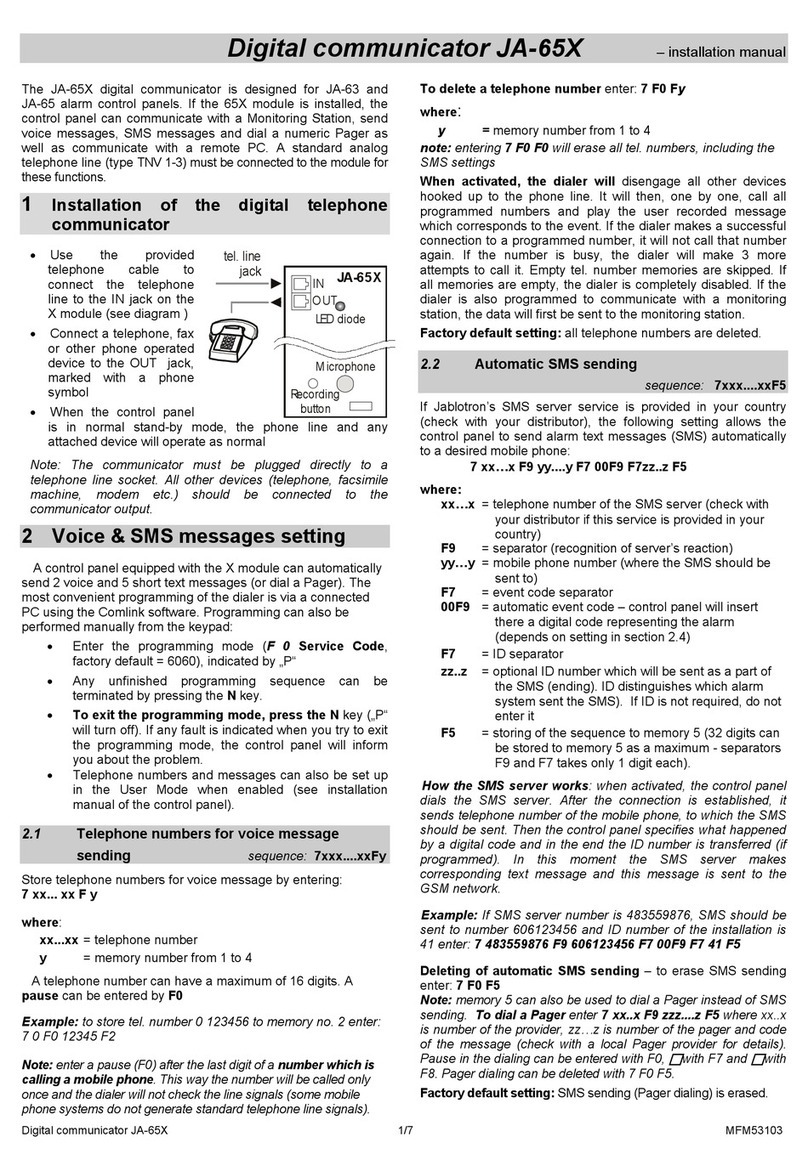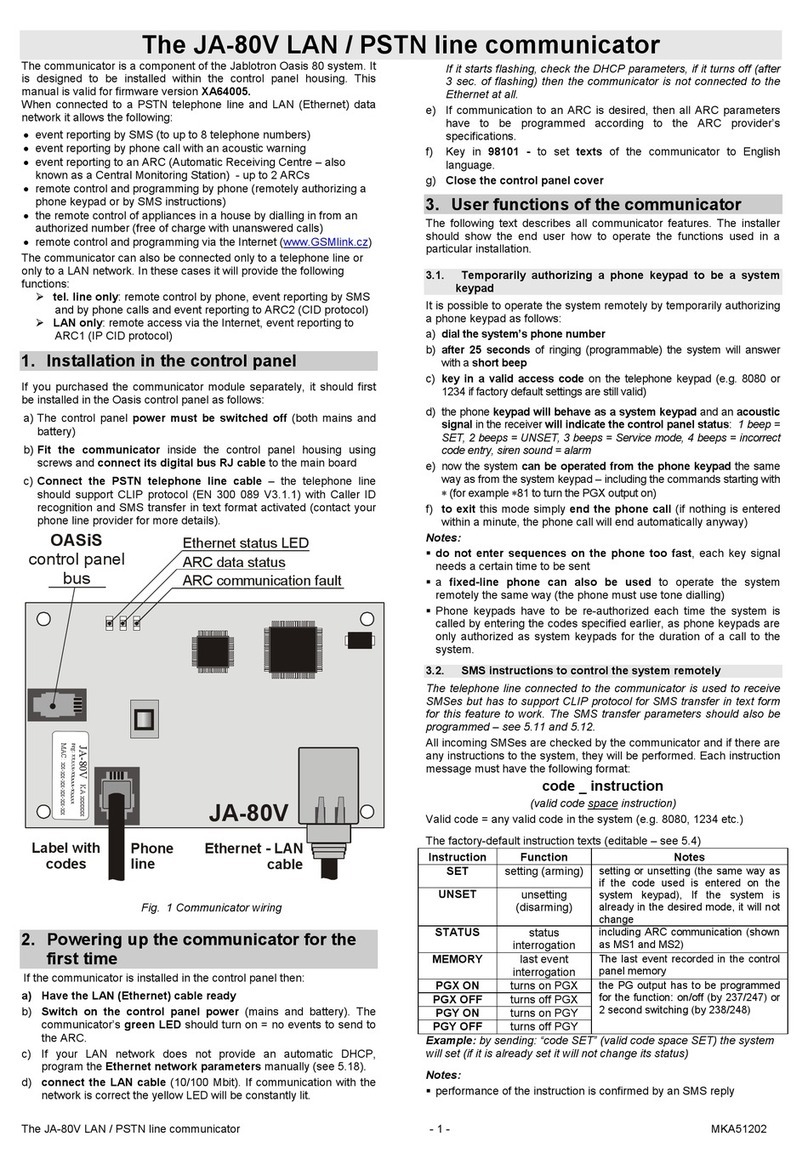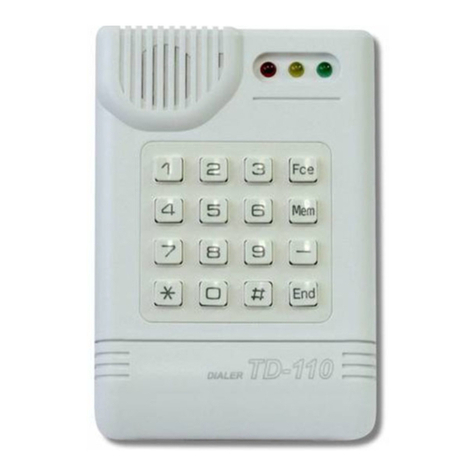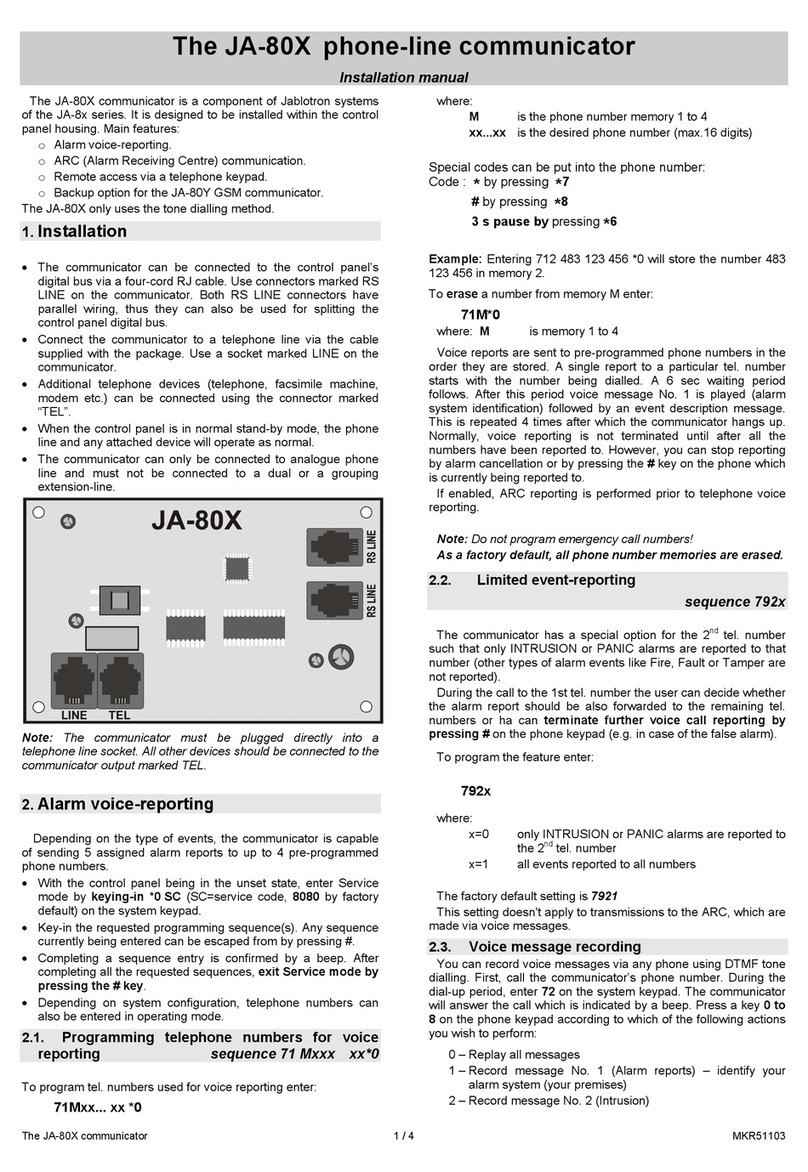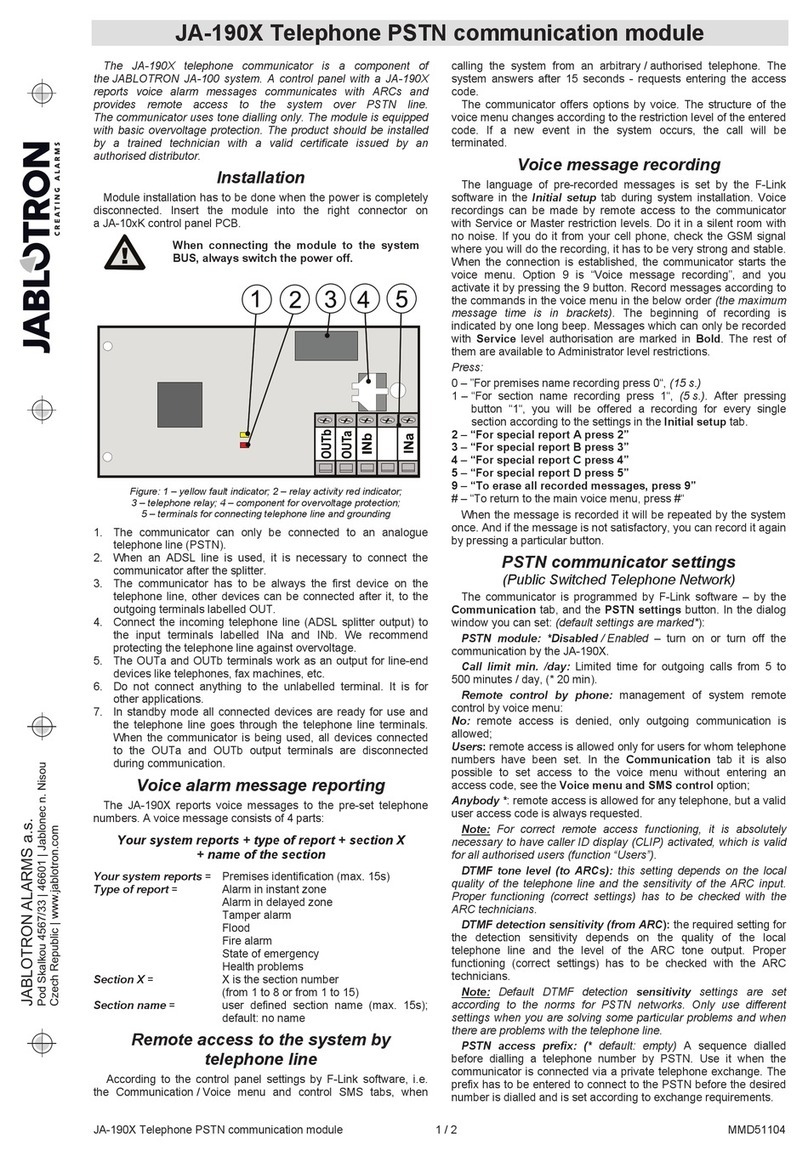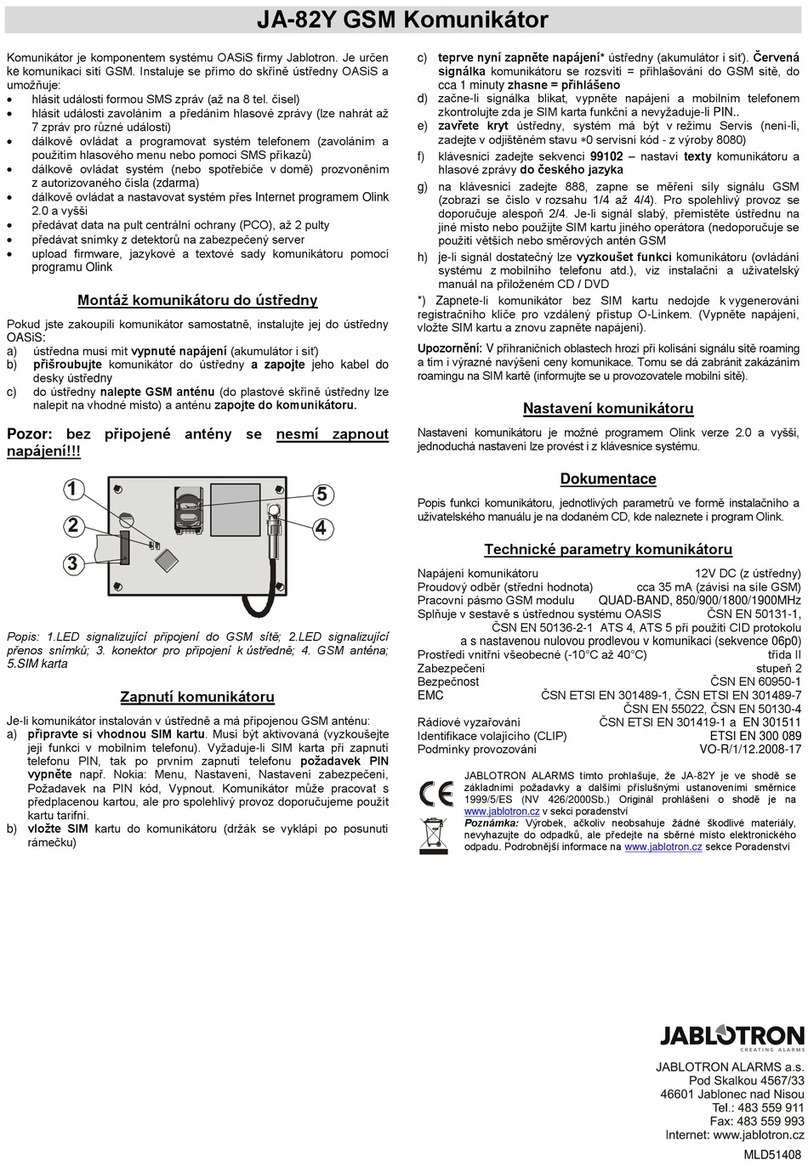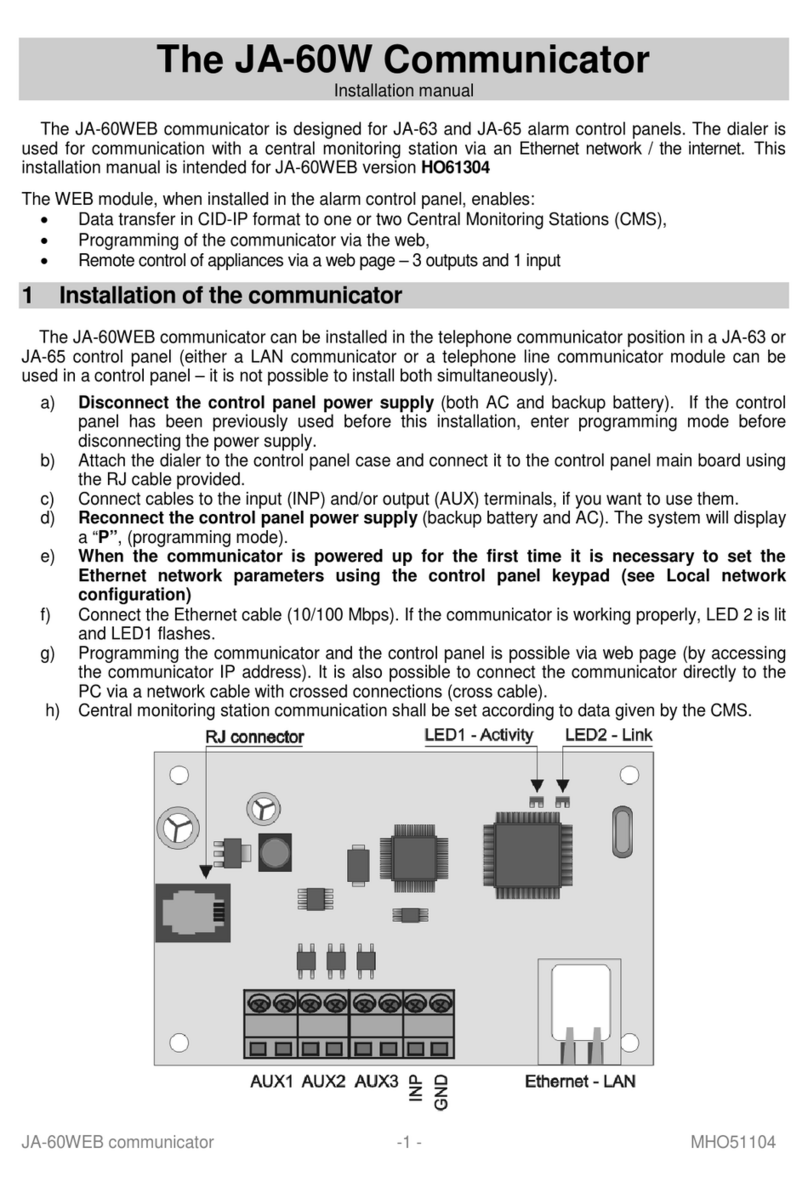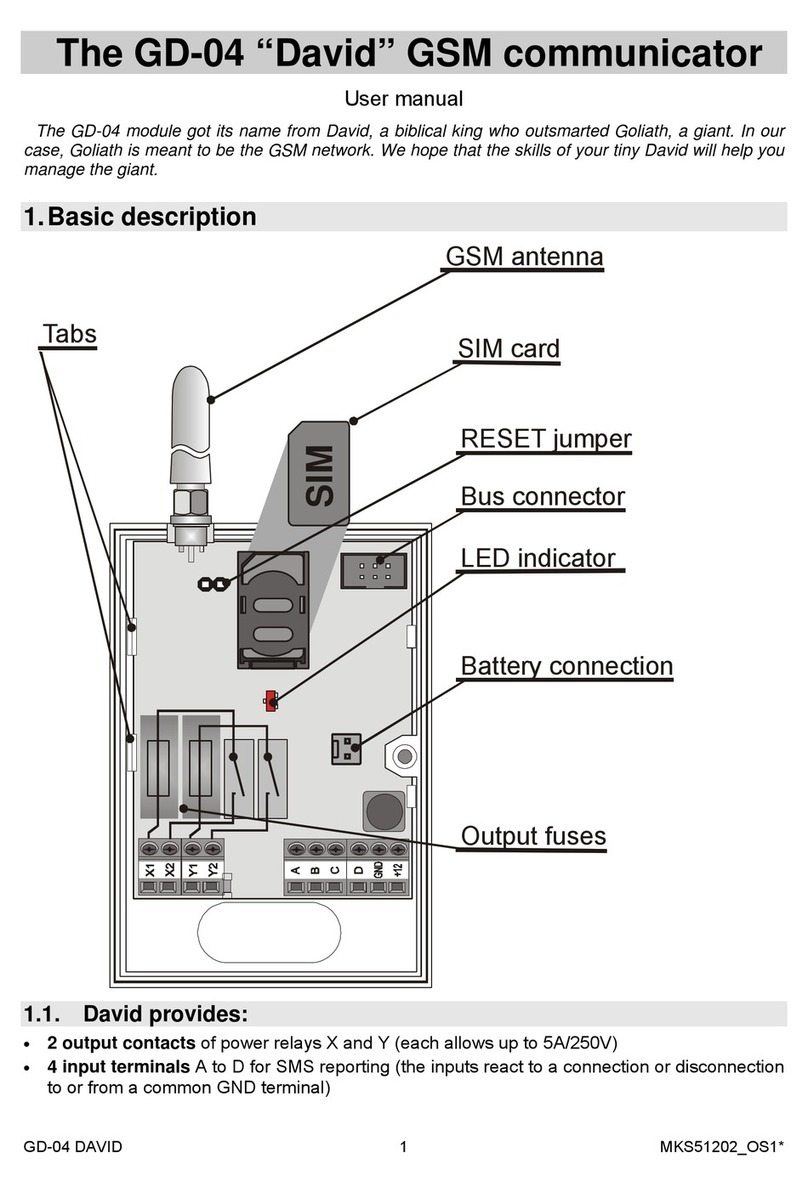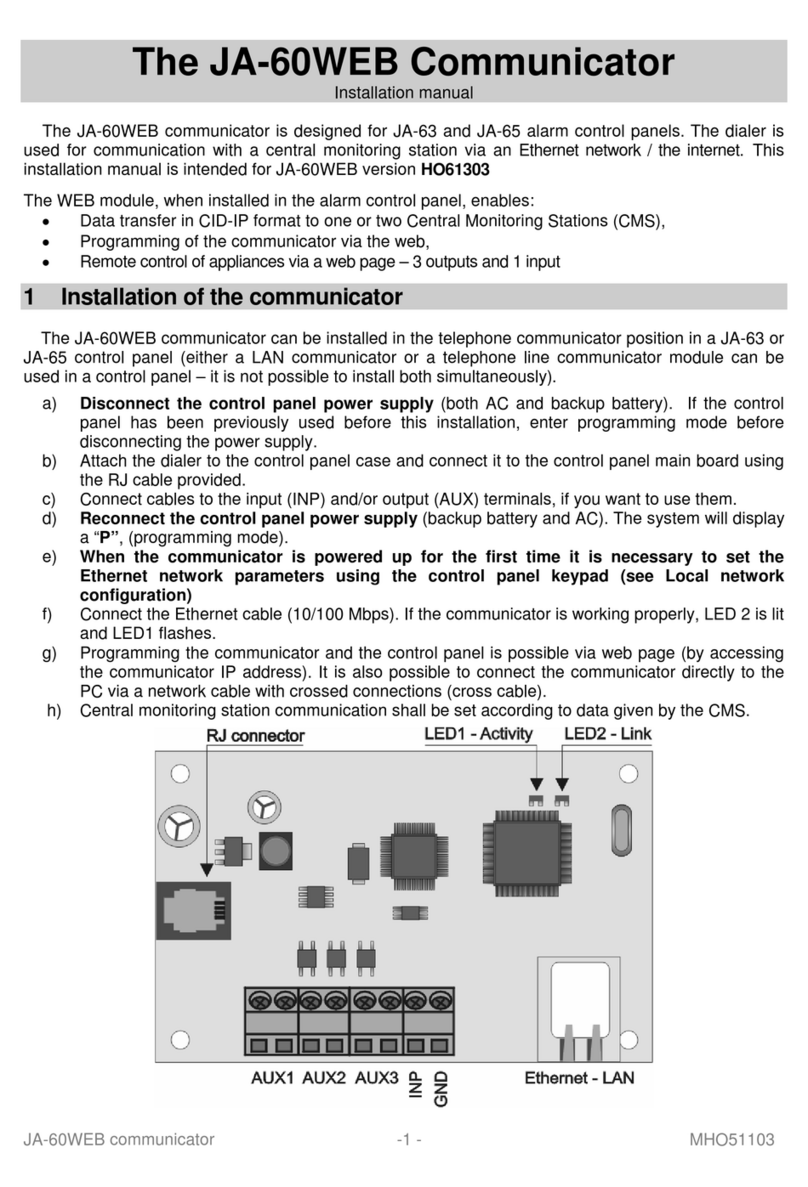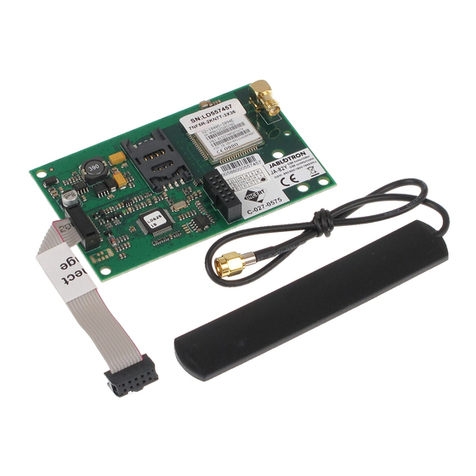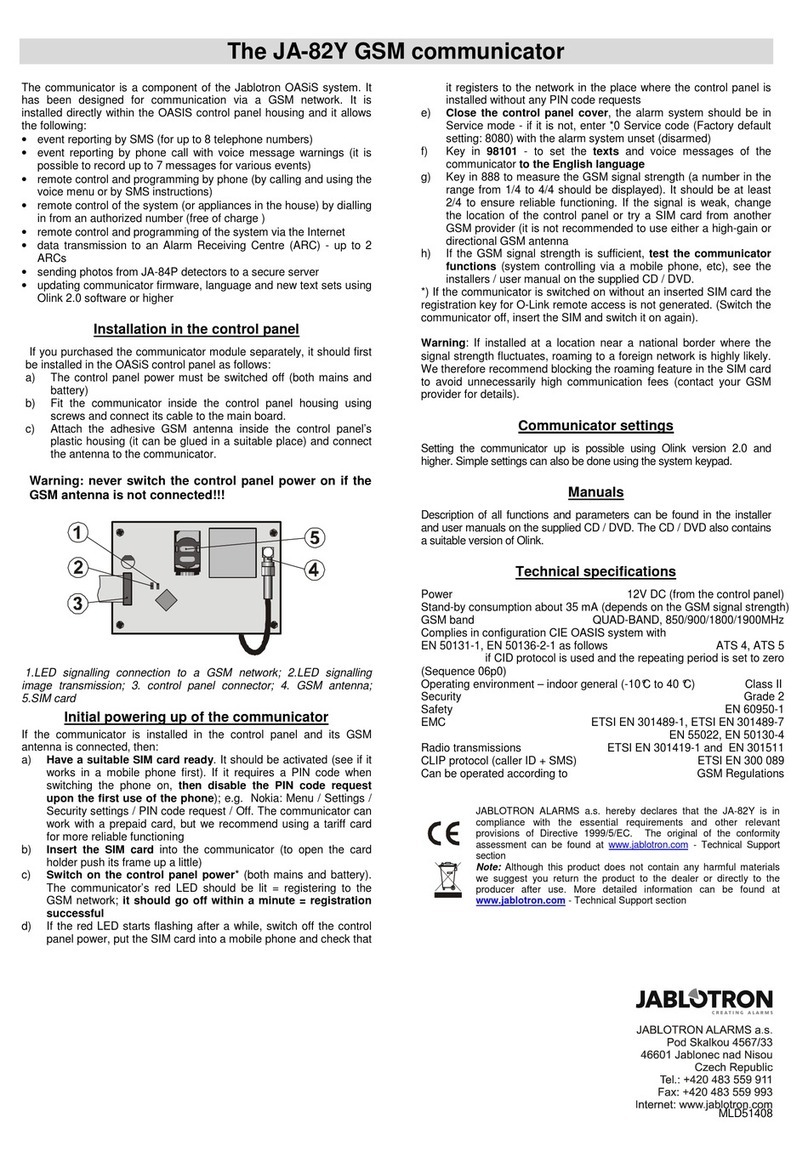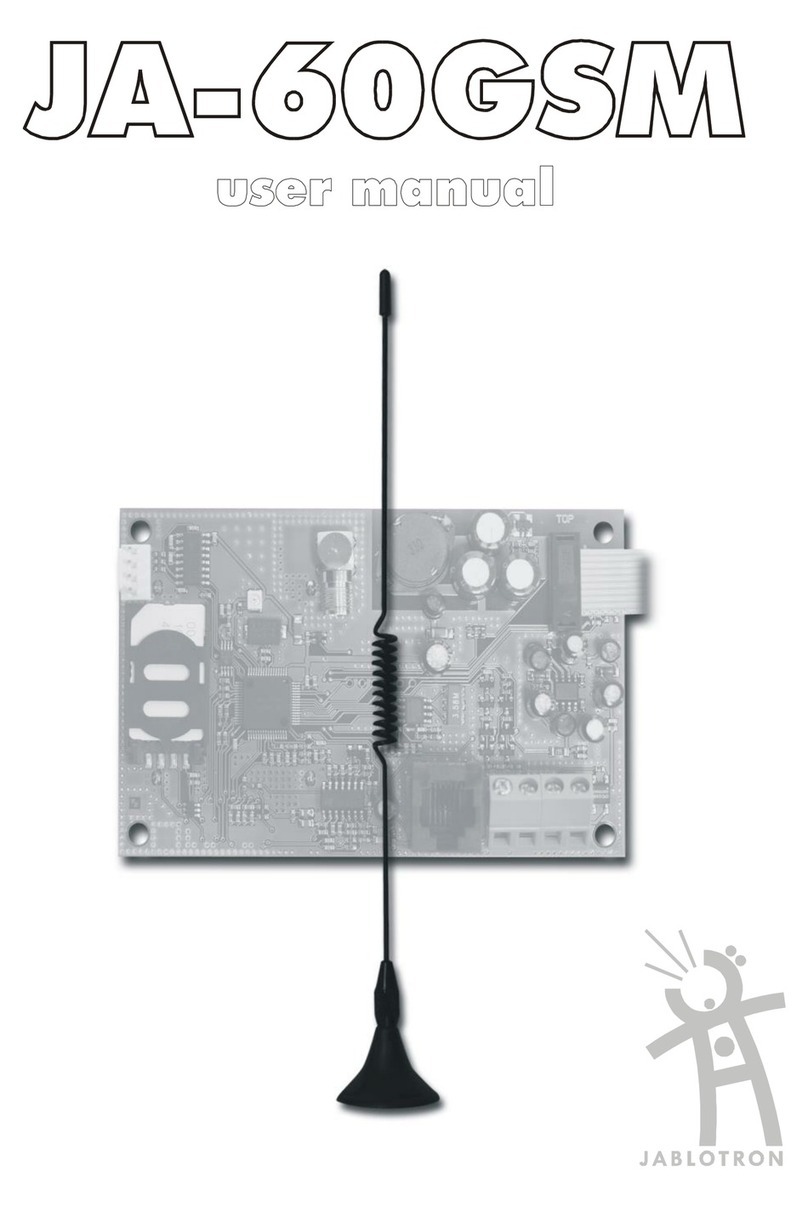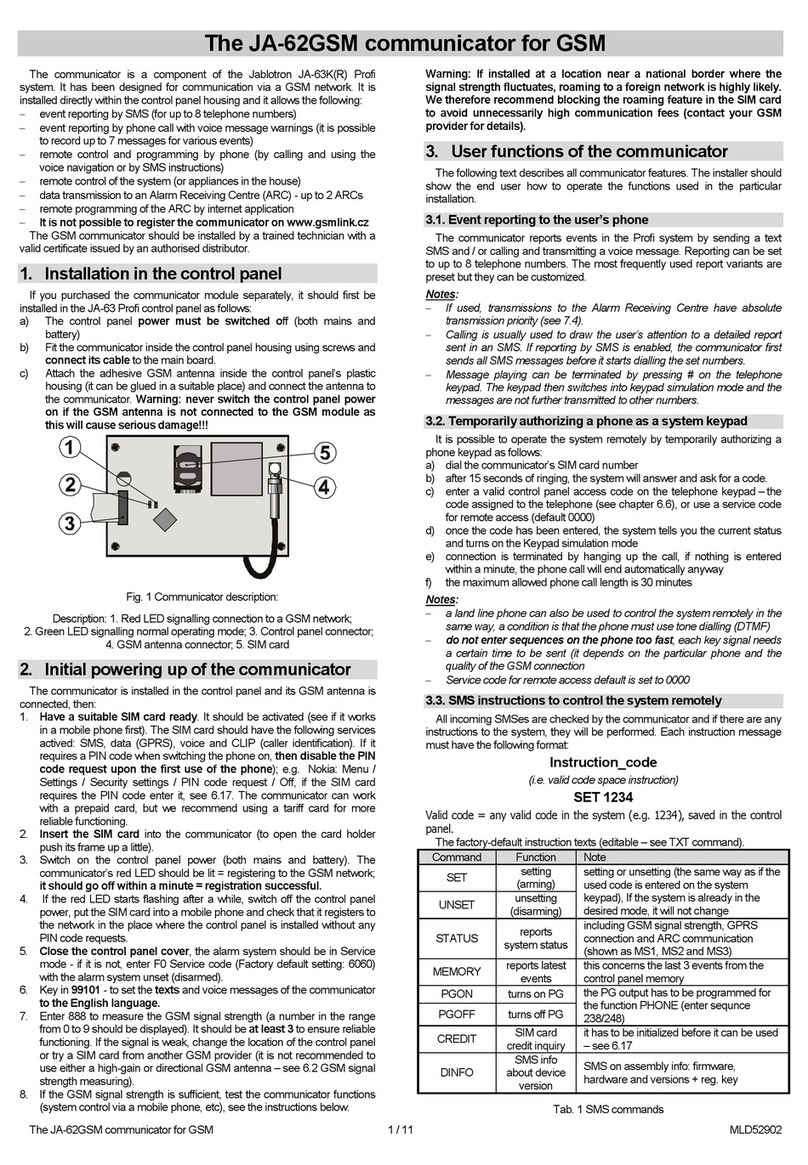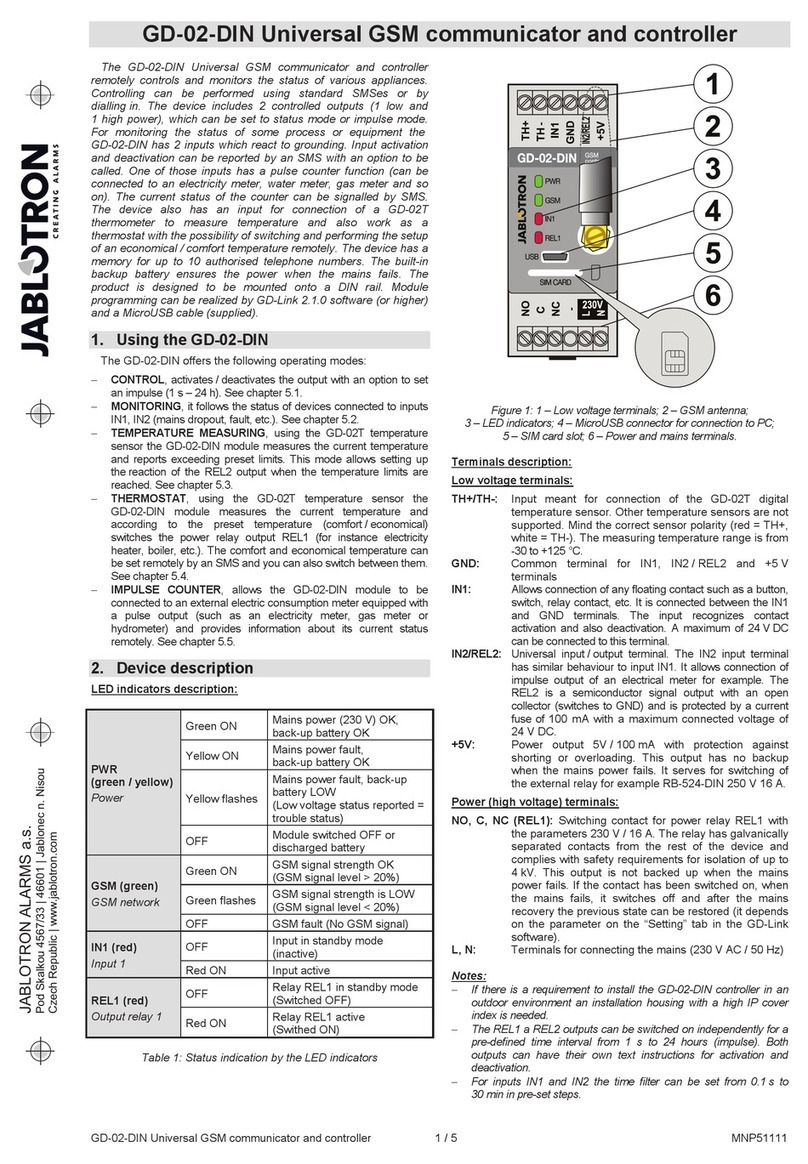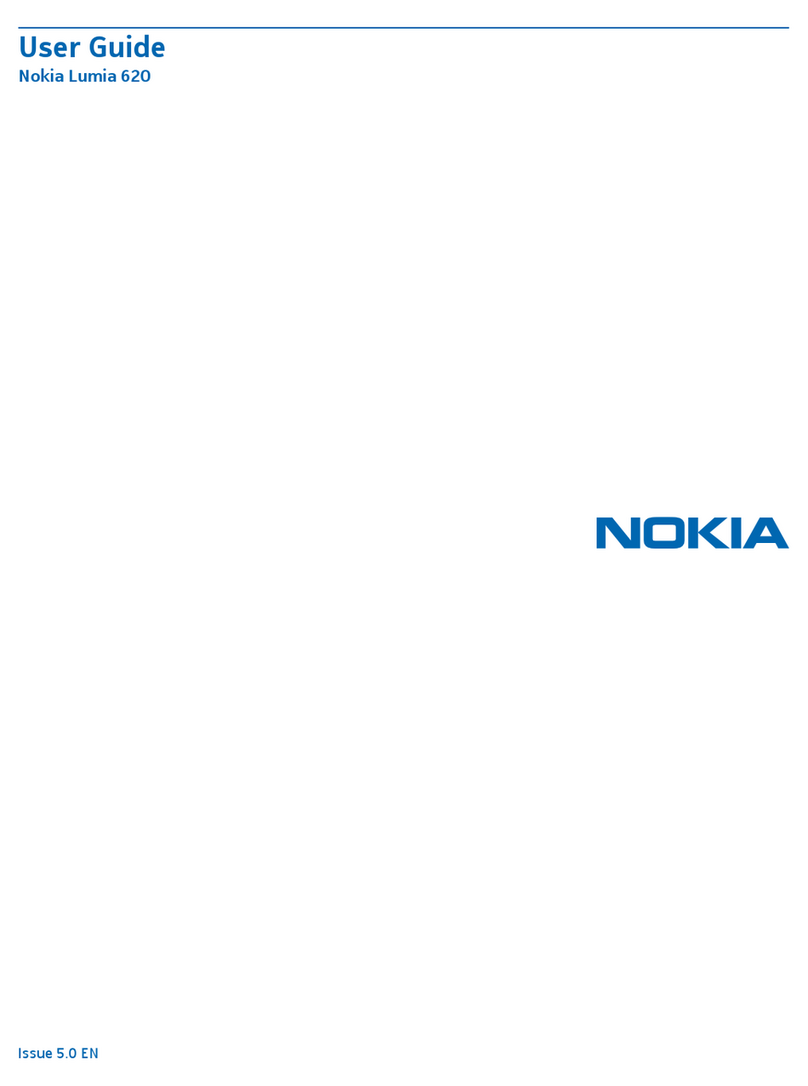The JA-80Y GSM communicator - 2 - MFJ55304
a) dial the system’s SIM card number (if a phone is connected to the
communicator’s simulated line it will start ringing)
b) after 25 seconds of ringing (programmable) the system will answer with
a short beep
c) key in a valid access code on the telephone keypad (e.g. 8080 or 1234
if factory default settings are still valid)
d) the phone keypad will behave as a system keypad and an acoustic
signal in the receiver will indicate the control panel status: 1 beep =
SET, 2 beeps = UNSET, 3 beeps = Service mode, 4 beeps = incorrect
code entry, siren sound = alarm
e) now the system can be operated from the phone keypad the same way
as from the system keypad – including the commands starting with ∗(for
example ∗81 to turn the PGX output on)
f) to exit this mode simply end the phone call (if nothing is entered within
a minute, the phone call will end automatically anyway)
Notes:
do not enter sequences on the phone too fast, each key signal
needs a certain time to be sent (it depends on the particular phone and
the quality of the GSM connection)
a fixed-line phone can also be used to operate the system remotely
the same way (the phone must use tone dialling)
the system can also be operated from the keypad of a phone
connected directly to the communicator’s simulated line. It is only
necessary to pick up its receiver and briefly press the # key. Then the
phone is ready to work as a control panel keypad. To finish operating
just hang up.
Phone keypads have to be re-authorized each time the system is
called by entering the codes specified earlier, as phone keypads are
only authorized as system keypads for the duration of a call to the
system.
3.4. SMS instructions to control the system remotely
All incoming SMSes are checked by the communicator and if there are
any instructions to the system, they will be performed. Each instruction
message must have the following format:
code instruction
(valid code space instruction)
Valid code = any valid code in the system (e.g. 8080, 1234 etc.)
The factory-default instruction texts (editable – see 5.5)
Instruction Function Note
SET setting (arming)
UNSET unsetting
(disarming)
setting or unsetting (the same way as
if the used code is entered on the
system keypad), If the system is
already in the desired mode, it will not
change
STATUS status
interrogation including GSM signal strength, GPRS
data, ARC communication (shown as
MS1 and MS2)
MEMORY last event
interrogation The last event recorded in the control
panel memory
PGX ON turns on PGX
PGX OFF turns off PGX
PGY ON turns on PGY
PGY OFF turns off PGY
the PG output has to be programmed
for the function: on/off (by 237/247) or
2 second switching (by 238/248)
AUX ON turns on AUX
AUX OFF turns off AUX turns a pair of AUX terminals on the
communicator module on/off
CREDIT SIM card credit
interrogation it has to be initialised by SMS before it
can function – see 5.17
Example: by sending: “code SET” (valid code space SET) the system
will set (if it is already set it will not change its status)
Notes:
performance of the instruction is confirmed by an SMS reply
the instruction texts are not case-sensitive and only ASCII characters
are allowed
only one instruction can be in an instruction SMS
a setting/unsetting instruction starting with the service code will only be
performed if setting/unsetting with the service code is enabled in the
control panel (to protect against unauthorized setting/unsetting by
installers)
an SMS instruction can also be sent to the alarm system from a phone
connected to the communicator (if supports SMS) – to phone number
001 (for free)
if there is any other text in the instruction not separated by “%”, the
instruction will not be performed
if you are sending an instruction and you are not sure whether any
other text will be automatically added to the SMS (for example, when
using an SMS internet gate) type the instruction as: %code
instruction%%
3.5. Toll-free remote control by unanswered calls from pre-
authorized phones
A limited number of system functions can be activated remotely by
calling the system from pre-authorized phones and terminating calls
before the system answers. This way limited control of the system is free
of call charges. It is possible to pre-authorize phone numbers stored in
memories M1 to M8 (also used for event reporting – see 4).
To pre-authorize a telephone number store ∗at the end of the number
and follow it by a single digit (1, 2, 3, 8 or 9) – see the notes in section 4.
If this number calls, the communicator generates “∗digit“ after the first
ring (as if it had been entered manually on the system keypad). This toll-
free remote control by unanswered calls enables the following functions
according to the digit stored at the end (after the *) of the tel. number in
memory:
∗1setting the complete system (= ABC keypad button)
∗2setting section A (= A button)*
∗3setting sections A & B or B (= B button)*
∗8PGX turns on for 2 sec. (if PGX is programmed for the pulse
function)
∗9PGY turns on for 2 sec. (if PGY is programmed for the pulse
function)
Notes:
if a phone sends no caller identification data it cannot be used for
this type of remote control by phone
if phone calls end before the control panel answers, remote control is
for free
a phone which is pre-authorized for toll-free remote control can also
temporarily authorize its keypad to fully operate the system (see
3.3) – just let it ring until the control panel answers the call
if it is desired that the phone which is authorized for toll-free remote
control should not receive event reports, then turn the reports off for
that tel. number (see 5.4).
setting (arming) with ∗1, ∗2 and ∗3 will work only if enabled in the
control panel
4. Reporting to phones
The communicator can report events occurring in the Oasis system by
sending SMS reports and/or by calling phone numbers with an acoustic
signal (mostly used as audible notification of an SMS to be read). Reporting
can be programmed for up to 8 phone numbers.
The most frequently desired reports are already assigned to the telephone
number memories by factory-default, so you only need to program tel.
numbers to the particular memories which have the desired reports already
assigned. If desired, other events can be reported to the number too, i.e. the
list of event reports assigned to the number can be changed (see 5.4)
Factory-default reports assigned to the numbers M1 to M8
M Reports
1
2 Alarms and faults by SMS
3
4 Alarms and faults by SMS + phone call (if you answer the
call you hear a siren sound)
5
6 Alarms by SMS + a phone call, with Setting/Unsetting
and faults by SMS only
7 Alarms by phone call (if you answer the call you hear a
siren sound)
8 Technical fault by SMS (suitable for an installer)
To program phone numbers to the M memories, enter the following
sequence while in Service mode:
81 M xxx...x ∗0
where:
M is memory 1 to 8
xxx...x is a phone number (max. 20 digits)
Example: entering 81 5 777 777 777
∗
0 will store the number
777777777 in memory M5 (Alarms will be reported by SMSes + phone
calls, Setting/Unsetting and faults only by SMS)
To erase a number from memory M enter: 81 M ∗0
Notes:
Entering ∗9before the first digit will insert a “+” for the international
formatting of phone numbers
